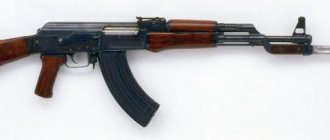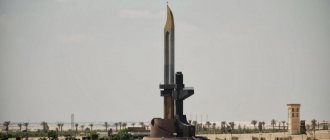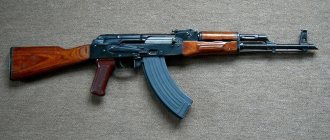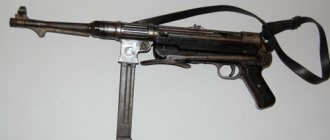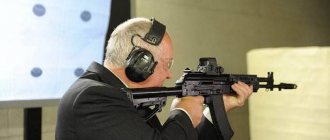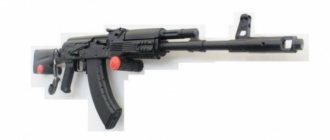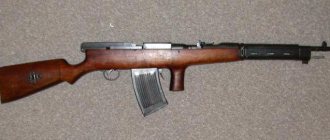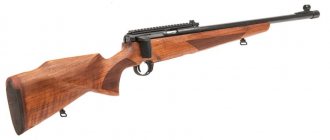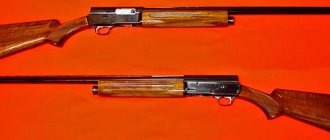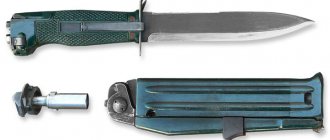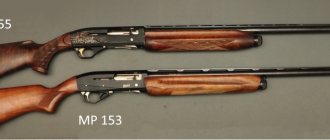The main brainchild
The machine gun was put into service in 1949. Its official name is “7.62 mm Kalashnikov assault rifle model 1947” (AK-47). It is also often called simply “Kalash”. According to the designer himself, the main qualities of his weapons are “simplicity and reliability.”
“I created a machine gun when I was a sergeant, and I always remembered that a soldier did not graduate from academies,” said Kalashnikov.
The Kalashnikov assault rifle is not very expensive due to its ease of production. In some countries it is bought cheaper than chicken.
Foreign Policy magazine estimates that the cost of one AK assault rifle on the black market ranges from $10 in Afghanistan to $3,800 in India. In the USA, a Kalashnikov assault rifle can be purchased for $70–350.
The Kalashnikov assault rifle is included in the Guinness Book of Records as the most common weapon in the world. Currently, there are about 100 million AKs in the world. This means that for every 60 adult inhabitants of our planet there is one machine gun. It is in service with the armies and special forces of 106 countries.
The Kalashnikov assault rifle is depicted on the coats of arms of some states. Currently, it is present on the coat of arms of the African country of Zimbabwe (since 1980), on the coat of arms and flag of Mozambique (since 1975), and the coat of arms of the Asian state of East Timor. From 1984 to 1997, the AK was depicted on the coat of arms of the African state of Burkina Faso. AK is also depicted on the emblem of the Lebanese group Hezbollah.
At the end of the 20th century, the French magazine Libération recognized the Kalashnikov assault rifle as the invention of the century. The famous weapon managed to bypass the atomic bomb and space technology.
In 2004, Playboy magazine named the Kalashnikov assault rifle one of the “50 Products That Changed the World,” ranking it behind the Apple Macintosh computer, birth control pills, and the Sony Betamax VCR.
It is believed that more people were killed by the Kalashnikov assault rifle than by artillery fire, aerial bombing and rocket attacks. A quarter of a million people are killed by AK bullets every year.
The legendary Russian gunsmith Mikhail Kalashnikov always said that all his life he invented weapons for protection, not for killing:
“I sleep peacefully because I have always created weapons for protection.” It is the politicians who cannot agree and use him to kill.
How did a self-taught inventor, a man without a higher education, and even the son of a kulak, Mikhail Kalashnikov, manage to invent such a perfect murder weapon?
© ITAR-TASS/Udmurtskaya Pravda newspaper
The first Kalashnikov assault rifle
It was in this class of weapons that Kalashnikov made his first and greatest breakthrough. He designed the AK-46 for the “intermediate” 7.62*39 mm cartridge.
He presented his invention to the Ministry of Defense at an assault rifle competition in 1946. Or, in modern terms, at a tender for the selection of new main small arms for the Soviet army.
After the gas carbine, Mikhail Timofeevich did not interfere with the creation of assault rifles with an intermediate cartridge. The undisputed favorite in those years was Sudaev with his AS-44.
But the war was drawing to a close, and the army command decided not to rush into rearmament. Despite all the positive qualities, the disadvantage of the AS-44 was its impressive weight and the presence of a bipod. Such machine guns could arm 2-3 people in a squad, and the generals were not happy with this. A new competition was appointed.
Kalashnikov made changes to the design of his self-loading carbine. But by the time the competition was held, the future AK was still very far from perfect. The problem remained the same: shooting accuracy. To put it bluntly, the Kalashnikov assault rifle was an outsider in terms of shooting accuracy among all the samples submitted to the competition.
But it also had undeniable advantages: a small number of rubbing parts, ease of manufacture and assembly, a large supply of energy, which allowed the machine to grind small debris that got inside into dust. The generals, taught by the bitter experience of the recent war, appreciated the highest reliability of the weapon. And they gave the designer the opportunity to modify the machine.
So the first AK-46 became the prototype for the development of a family of experimental rifles.
Stages of the long journey
Mikhail Timofeevich Kalashnikov was born in the village of Kurya, Altai Territory. He was the seventeenth child in a large peasant family, where nineteen were born and only eight children survived.
In 1930, the family of his father, Timofey Aleksandrovich Kalashnikov, recognized as a kulak, was exiled from the Altai Territory to the Tomsk region, the village of Nizhnyaya Mokhovaya.
Since childhood, Misha Kalashnikov was interested in technology, studying the structure and operating principles of various mechanisms. At school I was interested in physics, geometry and literature. After finishing the seventh grade, with the permission of his parents, he returned to Altai, to Kurya, but was unable to get a job. After studying there for another year, he decided to return to his mother and stepfather, where he received a passport by forging the stamp on the certificate (the son of a kulak was not entitled to a certificate). This is where the confusion with the biography of our hero begins. In some documents, his date of birth is November 10, 1919, in others - on the 19th of the same month.
A few months after returning to Kuryu, he first became acquainted with the design of a weapon, disassembling a Browning pistol with his own hands. I wonder where he got it and where the Cheka was looking?
At the age of 18, Misha left his native village and moved to the Alma-Ata region of the Kazakh SSR, where from 1936 to 1938 he worked as a technical secretary of the political department of the 3rd department of the Turkestan-Siberian Railway. Probably, he was so bored with the bureaucratic work in the political department that the boy wanted to do something himself, with his own hands.
Personal life
In the biography of Mikhail Kalashnikov there are 2 marriages. The man’s first wife was Ekaterina Danilovna Astakhova, who was born in the Altai Territory and later worked at the Matai station railway depot. In 1942, a son, Victor, appeared in the family. Later, Mikhail Timofeevich and Ekaterina Danilovna broke up. The ex-wife and child remained in Kazakhstan. In 1956, the woman died suddenly, so Kalashnikov moved his son to Izhevsk.
Mikhail Timofeevich’s second wife was Ekaterina Viktorovna Moiseeva. The woman worked as a design technician. From her first marriage the woman had a daughter, Nelly. But Kalashnikov adopted the girl.
Later, more children appeared in the family - Natalya and Elena, the latter holds the post of president of the Interregional Public Fund named after. M.T. Kalashnikov. Unfortunately, Natalya died at the age of 30. Mikhail Timofeevich was known as a happy father and grandfather. The children gave birth to five grandchildren: Mikhail, Alexander, Evgeniy and Alexander, Igor.
The difficult path to a dream
In the fall of 1938, Mikhail Kalashnikov was drafted into the Red Army in the Kiev Special Military District. After the course for junior commanders, he became a tank driver and served in the 12th Tank Division in the city of Stryi (Western Ukraine).
Already there he showed, perhaps not inventive abilities, but ingenuity: he developed an inertial counter for shots from a tank cannon, an adaptation for a TT pistol to increase the efficiency of firing through slots in the tank’s turret, and a counter for the tank’s service life.
This counter was the first invention of the young Kalashnikov tankman, but so significant that he was called to report on it to the commander of the Kyiv Special Military District, Army General Georgy Zhukov. After a conversation with the commander, Mikhail is sent to the Kiev Tank Technical School for the production of prototypes, and after completion of the tests to Moscow for comparative tests and then to the Leningrad Voroshilov Plant for refinement and launch into series.
Kalashnikov began the Great Patriotic War in August 1941 as a tank commander with the rank of senior sergeant. In October of the same year, near Bryansk, he was seriously wounded. In the hospital, I really got excited about the idea of creating my own model of automatic weapons. He began to make sketches and drawings, comparing and analyzing his own impressions of the battles, the opinions of his comrades in arms, and the contents of the books in the hospital library. The advice of one paratrooper lieutenant, who had worked at some research institute before the war and had a good knowledge of small arms systems, as well as the history of their creation, was also useful.
Returning home, with the help of depot specialists (!), three months later he created a prototype of his first model of a submachine gun. Later, the sample was presented to the head of the Military Engineering Academy named after. F. E. Dzerzhinsky to A. A. Blagonravov, an outstanding scientist in the field of small arms.
As one might expect, Blagonravov's review was negative. And this was clear: a submachine gun (SMG) is not a spoon, you can’t do it on your knee. The Main Artillery Directorate (GAU) of the Red Army also did not recommend adopting the Kalashnikov PP for a number of technological reasons, in particular, the conclusion stated that “the Kalashnikov submachine gun is more difficult and expensive to manufacture than the automatic weapons PPSh-41 Shpagin and PPS Sudaev, and requires the use of scarce and slow milling operations. Therefore, despite a number of innovations, it is not of industrial interest in its present form.” This is how Kalashnikov’s first step in creating a PP ended unsuccessfully.
“Before Kalashnikov came to my unit, he worked in Alma-Ata together with the gunsmith Kazakov,” the head of the testing unit, Vasily Lyuty, later recalled. — The samples were sent to the State Agrarian University Research Site in Golutvin. However, these samples were not tested by shooting because they were too primitive. Contrary to what Kalashnikov writes and talks about himself in newspapers and magazines, I responsibly declare that while working in Kazakhstan, he did not create anything worthy of attention. Mikhail Timofeevich is a very talented person. However, in terms of the level of general educational training, practical knowledge and experience, he did not reach the professional designers who armed the army...”
© ITAR-TASS
Death
Kalashnikov started having health problems in 2012. The designer's assistant stated that this was the reason for leaving his job. In December of the same year, the man was hospitalized at the Republican Clinical Diagnostic Center of Udmurtia for a routine examination. Another deterioration in health was recorded in the summer of 2013. Mikhail Timofeevich was transported to Moscow by means of an EMERCOM aircraft with special equipment.
“Due to the need for a medical examination, doctors decided to send Mikhail Timofeevich to one of the Moscow clinics,” said the press service of the Ministry of Emergency Situations.
Moscow doctors diagnosed the gunsmith with pulmonary embolism. For several weeks, the capital’s doctors pored over Kalashnikov. As a result, the man’s well-being improved, after which the designer returned home to Izhevsk.
In November, Mikhail Timofeevich felt unwell again, so on the 17th the designer was hospitalized in the intensive care unit of the Republican Clinical Diagnostic Center of Udmurtia. Kalashnikov’s relatives believe that the gunsmith’s health was affected by preparations for the celebrations on the occasion of Mikhail Timofeevich’s 94th birthday.
View this post on Instagram
A post shared by Prrosto Mari (@prrosto_mari)
Yuri Borisov as Mikhail Kalashnikov
In early December, Kalashnikov underwent emergency surgery, but the surgical intervention worsened the designer’s condition. After a month, doctors did not notice any visible improvements. A few days before his death, the gunsmith was transferred to intensive care due to stomach bleeding. The death of Mikhail Timofeevich became known on December 23.
Farewell to Mikhail Kalashnikov took place on December 25 and 26, and the funeral service took place in St. Michael’s Cathedral in Izhevsk. In connection with the death of the designer, mourning was declared in Udmurtia by order of the head of the region. Kalashnikov's funeral took place in the Pantheon of Heroes of the Federal War Memorial Cemetery.
The burial ceremony was attended by officials and key figures of the state, including Vladimir Putin and Sergei Shoigu, Andrei Vorobyov and Sergei Ivanov, Denis Manturov. State Director General Sergei Chemezov expressed his condolences. A monument to Mikhail Kalashnikov appeared on the Garden Ring in Moscow. The designer was awarded the “Gold Star” and “Hammer and Sickle” medals for the created weapon.
One of many
Then Kalashnikov worked for several years at the Central Research Site for Small Arms and Mortar Weapons of the GAU RKKA. During this time he did not create anything meaningful. And suddenly the machine gun he developed for the 7.62×39 intermediate cartridge of the 1943 model won the 1947 competition and was put into service.
The main criteria for the new weapon were announced: maneuverability, rate of fire, lethal effect of the bullet and shooting accuracy. At the first stage of the 1946 competition, sixteen preliminary designs of machine guns from such outstanding designers as Shpagin, Sudaev, Degtyarev and many others were presented to the SAM GAU.
Then, based on the decision of the competition commission, six projects were recommended for field testing, including Kalashnikov weapons. The remaining projects were rejected.
In the end, Kalashnikov won. Due to what? As he himself said in his memoirs, there was nothing in his machine that he would have invented himself. This entire machine consists of components invented at different times by other inventors.
In particular, the barrel bore was locked by two lugs of the bolt rotating around its longitudinal axis. M. T. Kalashnikov was prompted to do this by the design of the bolt of the American M1 Garand rifle.
The machine was fed with cartridges from a detachable, quick-change, sector-type steel box magazine with a double-row arrangement of 30 rounds, which, according to domestic experts, “...was borrowed from the Sudaev machine gun.”
Kalashnikov abandoned the composite milled receiver, open at the top to dirt and sand. It was replaced with a closed stamped-welded box, which largely repeated a similar design in the German MP-43 assault rifle.
The designer used in his weapon a trigger mechanism “with interception of the trigger,” which was invented in the 20s by the Czech Emmanuel Holek. In its pure form, such a mechanism was used on the Schmeiser machine gun.
On one of the variants of his machine gun, the Soviet designer used a metal butt that folds under the receiver, structurally similar to the folding butt of the German MP-38/MP-40 submachine guns.
In addition, Kalashnikov did not work alone. As many fellow designers recalled, he, for example, did not draw drawings. The design and calculation techniques were unknown to Mikhail Timofeevich.
Therefore, to assist in the creation of drawing documentation, experienced draftsmen, designers and process engineers were seconded to M. T. Kalashnikov.
The development of all technical documentation and the production of prototypes of Kalashnikov assault rifles was entrusted to a special design bureau and experimental work workshop of the Chief Designer Department (OGD) of Kovrov Plant No. 2.
© ITAR-TASS/ Grigory Sysoev
Front roads
Mikhail learned about the beginning of the war in Leningrad. The plant was evacuated to the East. Tanker Kalashnikov went to the front.
In October 1941, he was wounded in the battles near Bryansk, wounded, and came out of encirclement. Then there was confidence in the need for a new, compact submachine gun for tank crews. In the hospital, listening to the conversations of wounded soldiers from other branches of the military and their often extremely unflattering reviews of rifles, I realized that the entire army needed new weapons.
After the hospital, Mikhail Timofeevich received a six-month rehabilitation leave: the wound was severe, with concussion. He returned to the Matai depot and began making a new submachine gun. Precisely for manufacturing, since he thought out its design while still in the hospital.
Little is known about that first invention. It was a compact, portable weapon that was convenient to use in the cramped quarters of armored vehicles. But he had insufficient shooting accuracy. The sample required fine-tuning and was more difficult to manufacture than the Sudaev submachine gun, which was put into mass production.
Although Mikhail Kalashnikov's first submachine gun was not adopted for service, the designer's talent was noticed.
While working on the submachine gun, Mikhail Kalashnikov met Academician Blagonravov and already created his second machine gun on the basis of the evacuated Moscow Aviation Institute.
The Sinister Shadow of Hugo Schmeiser
There is currently a widespread belief in the West that the prototype for complete or partial copying in the development of the Kalashnikov AK-47 assault rifle was the German “assault rifle” StG-44 by Hugo Schmeisser. As reasons, supporters of this hypothesis often cite the external similarity between the samples and the fact that the AK-47 design was born during the work of a group of leading German gunsmiths in Izhevsk.
In addition, the study of the StG-44 by Soviet specialists took place at a plant in the city of Suhl, where 50 StG-44 samples were assembled and transferred to the USSR for technical evaluation.
One of the supporters of the Schmeisser theory puts it this way: “Have you noticed that the AK-47 is very similar to the Schmeisser assault rifle of the Third Reich? Have you ever guessed why? But because it had one author (or rather co-author) - Hugo Schmeisser.” True, it must be said that (without going into details) the Schmeiser and AK are noticeably different inside.
Doctor of Technical Sciences Yuri Bryzgalov, for example, believes that “the German MP-43 submachine gun is only slightly similar in appearance to the AK-47, the principle of its operation is completely different.” The fact that Kalashnikov collected and combined in his design all the best that was in the domestic and foreign arms industry, the professor gives him only credit, because “all gunsmith designers use this method when creating new types of weapons.”
Kalashnikov's merit in this case is not in the invention, but in the design. He is the designer of the machine gun. From the many different components created by others, he selected exactly those that optimally solve the problem facing him, the task of creating a weapon accessible to any fighter after the most minimal training, a weapon capable of working in any conceivable and unimaginable conditions, a weapon that is quite simple to produce, so that it can be produced in millions of copies, as they say, on the knee.
© ITAR-TASS/ Valery Sharifulin
Assault rifle
These rifles, as a new class of small arms, appeared among the Nazis on the Eastern Front in 1943.
The rifle was very effective: it multiplied the firepower of infantry, reduced the need to use light machine guns, and in single-fire mode it hit targets at a distance of up to 200 meters. That is, it combined the rate of fire of an assault rifle and the power of a conventional rifle.
A distinctive feature was a unique cartridge: weaker than a regular rifle, but much more powerful than a pistol cartridge. It was a shortened cartridge 7.92x33 mm.
The rifle was called "Sturmgever". Soviet military leaders realized that the future belonged to such weapons.
Awards
- 1946 – medal “For victory over Germany in the Great Patriotic War of 1941-1945.”
- 1947 – Order of the October Revolution
- 1949 – Order of the Red Star
- 1958, 1969, 1976 – Order of Lenin
- 1958, 1976 – Hero of Socialist Labor
- 1958, 1976 – Hammer and Sickle medal
- 1975 – Order of the Red Banner of Labor
- 1982 – Order of Friendship of Peoples
- 1985 – Order of the Patriotic War, 1st degree
- 1993 – Zhukov medal
- 1994 – Order of Merit for the Fatherland, II degree
- 1998 – Order of the Holy Apostle Andrew the First-Called
- 2004 – Order of Military Merit
- 2009 – Hero of the Russian Federation
- 2009 – Gold Star medal
